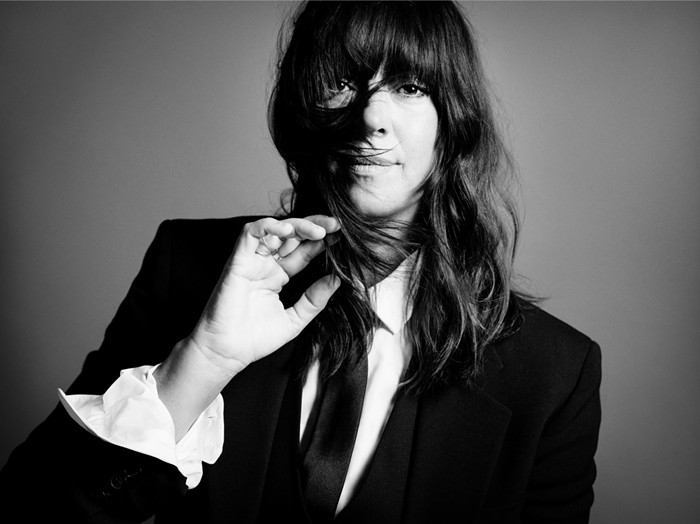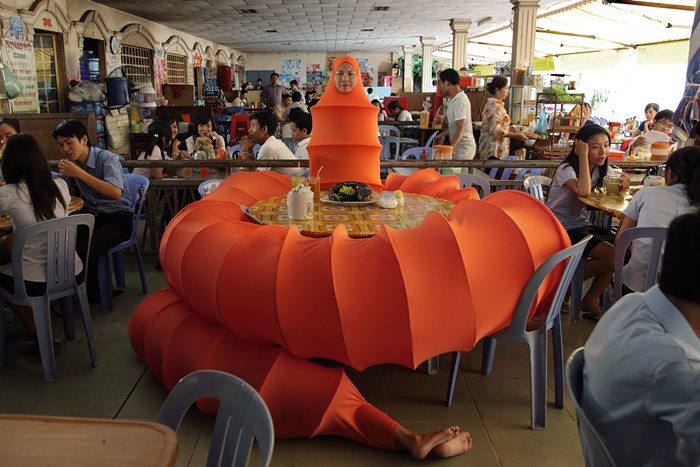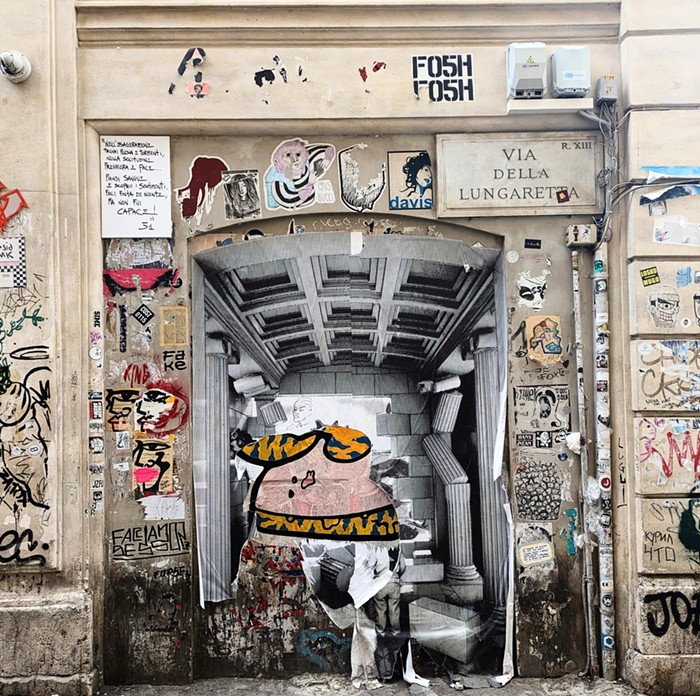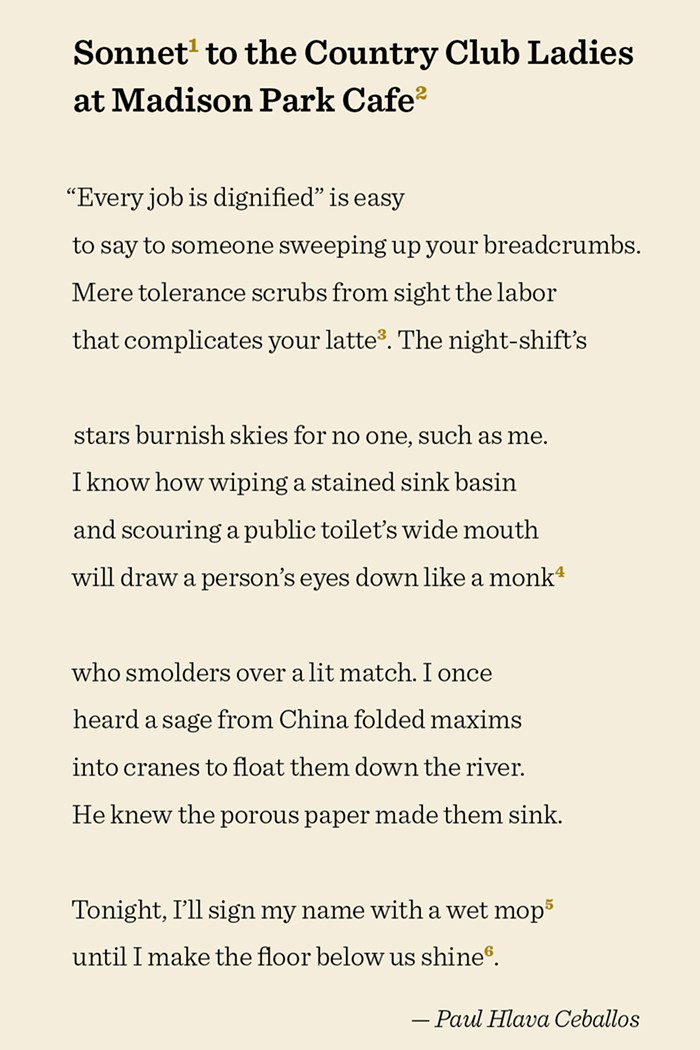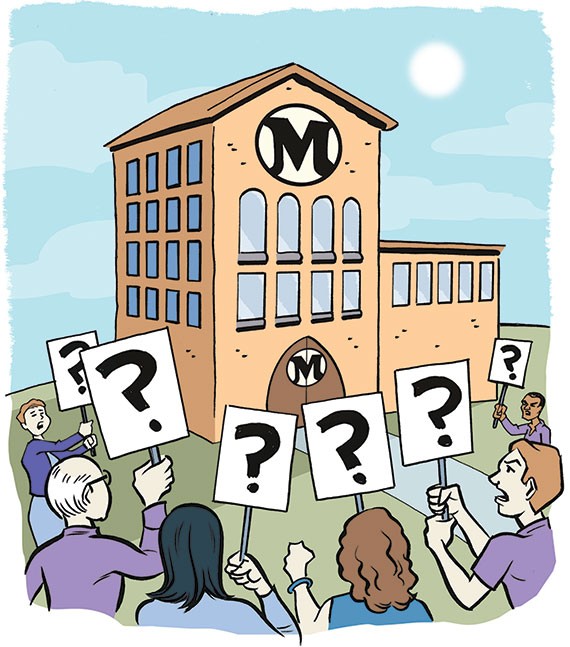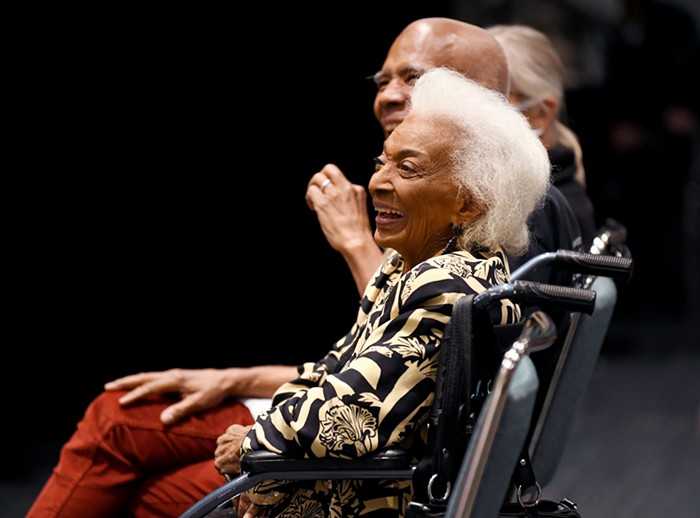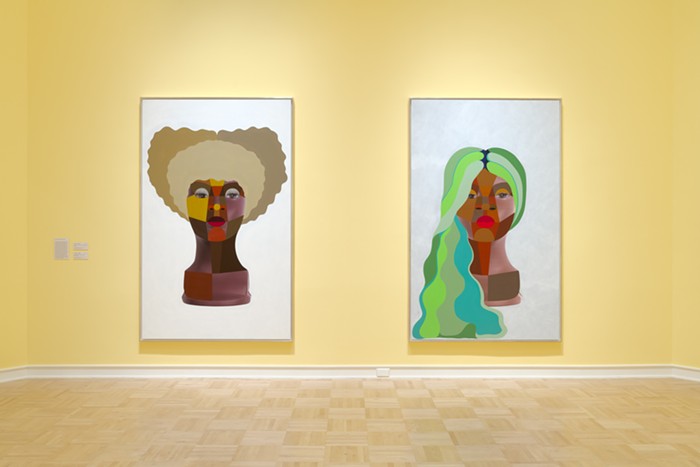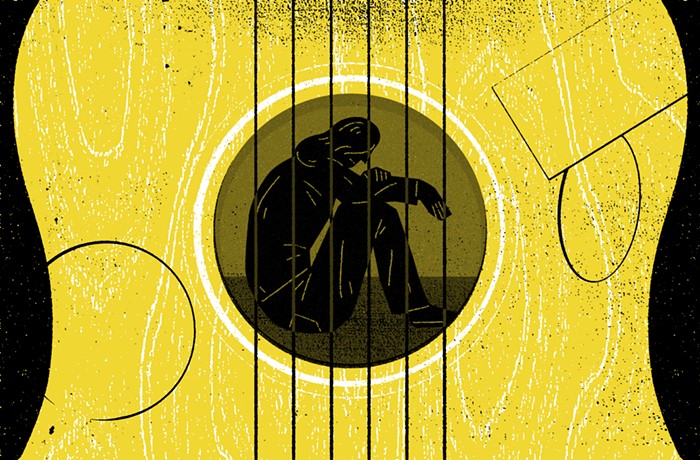
For her previous show, the Seattle artist who goes only by the name Ruthie V. painted ponds. Ponds she appreciated on quiet afternoons with an 80-year-old friend over tea.
But it’s even more complicated than that. You wouldn’t necessarily know she’s painting BDSM. There aren’t whips in the pictures. There aren’t chains. The only tip-off that Ruthie is dredging up secret, private experience—and even still you don’t know what it is—is one very dirty painting in the back of the show, facing away from the storefront windows, hidden from the street. (You've seen more explicit things, but the combination of the space and the picture's raunch factor is what makes it dirty.)
What is going on with Ruthie V.?
If she’s going to do the dirt in public, why is she only hinting at it in all but one painting? Is she being coy? Is she flirting? Inevitably.
But there’s something else—some far more interior aspect to this display of 10 lovingly worked-over oil paintings. For me it doesn't come through in all of them, but I prefer the ones where it does. There is no dualistic sadism or masochism here; there is far more dominance and submission in Eric Fischl's paintings of married couples than in any of these. I keep coming back to a portrait Ruthie made of a man seen lying on a bed through a doorway, some years ago, the light as hazy and pretty as fabric, and another still-life of a living room, and another work where her deployment of the color apricot is so moving, in the tradition of Matisse's interiors, that I can't remember what the picture is actually of, I can only remember the apricot. Ruthie V. is a traditional painter, and a very hard worker at it.
This latest work is a funny project. But of course she would paint BDSM this way.
The two most prominent paintings in the current show depict women in the bathtub, both seen from above, both upside down on the wall, feet upward. One is a sexy woman with parted lips and snake tattoos. But the other, Squirm, depicts a nude woman only from the waist down. The bathtub looks a little small for her, so she’s squishing herself up and wedging herself in. It looks uncomfortable, but the scene is entirely soft. The water is the most inviting aquamarine. This feels like where this woman wants to be, even if it hurts a little.
People are worried about Ruthie V., she tells me. Her friends, her family, they don’t want her to hurt, even if it's just a little, and even if that’s where she wants to be. She answers that they really needn’t worry. That this whole part of her life is not what they think.
Furthermore, she would like them to try BDSM themselves. At her artist talk.
At Ruthie’s artist talk tonight at Core Gallery at 6:30, she’ll give a standard lecture until 7:30, and then anyone who wants to can “escape,” she jokes.
The second half will be an intro to rope bondage, led by a veteran Seattle instructor.
It will be fully clothed. No whips, no chains. Kind of like the paintings.
I asked her to tell me everything. Here’s our conversation, edited.

How are you?
Nervous and excited.
So we’re here to talk about your new show, Subspace, at Core Gallery, which opened last week during First Thursday. But my experience of it started with your artist statement and press release. You wrote: “This is the most technically and emotionally challenging body of work I’ve ever done. You haven’t seen work like this from me before. This show is fluid, erotic, challenging, and frighteningly vulnerable. Some paintings may not be appropriate for younger viewers.”
So my last show was about slowing down, which was very important to me personally. Ironically, it was a bit boring because it was about slowing down.
That was your landscapes show at Shift, right?
Yeah. I ended up going to a meditation retreat because it was so hard for me to slow down and make space for things. I went on a no-talking, no-writing, no-painting, silent-meditation retreat. I wasn’t allowed to make eye contact, and I wasn’t allowed to talk to people or be productive or do anything. All I could do was sit. I was going nuts. I wanted to narrate my experiences, and I couldn’t. And I realized, that’s what’s going to keep me painting—going right for what my experiences are now. That [landscapes] show was good for me, but I’m not a landscape painter. And this was what was going on in my life this year, so I went right for it.
A couple of years ago, I married an engineer, so I don’t have to worry about my basic needs and I feel like I can try scary shit.
So what was going on in your life? It seems like there are almost two bodies of work here: the paintings in the front, and the paintings in the back, including Fuck, which presumably is the one you warned “may not be appropriate for younger viewers.”
Huh. That’s interesting, this idea that there are two bodies of work. That isn’t true. But each painting is a different aspect.
Fifteen years ago, I’m having some trouble, I’m making some bad decisions. What I did was, I went to every single therapist who would see me for a free session, I sat down on a chair and said here’s what I’m doing. I’d made a list of all the bad shit I was doing, and I watched what they said. Some were like, “Wow, that’s really bad, you need to stop.” Some were like, “I’m really concerned about you, let’s talk about the deeper reasons.”
I sat down in front of this woman and I said, “Here’s all the shit that I’m doing,” and she said, “Huh, I’m curious about that. What happens if you do it more? And then see what happens? Just notice how it feels.”
No one had ever said that to me before. No one had ever said try doing that bad thing more and see what happens, so I fell totally in love with this idea. If she had said up front that she was into Buddhism, meditation, and process psychology, I would have walked out the door, but she tricked me and didn’t tell me what she was doing until years later. She taught me mindfulness and awareness, but she also taught me a kind of process psychology where you follow curiosity, you try shit, and you see what happens.
What sort of stuff did you try?
When I was single and living in Bellingham, I was having trouble trusting people sexually. She said I could go to Seattle and hire a dom. I never did it, but I got excited about it. She said BDSM could be helpful as a different way of acting things out and changing my experience of being in and out of control of a situation.
Every couple years it kept coming up. When I was single, before I met my husband, I was online, dating. I met some people who were an introduction into dominance-and-submission play and it was really safe. I felt like, I can close my computer, nobody knows where I live, and I ended up having really supportive, rich relationships with people that I still talk to on a regular basis. One person I consider a friend and we were like, “Hey, have you tried this? Let’s try it. Wow! I didn’t know you could do that!”
I assume your husband is cool with this.
We have an agreement—he trusts that I won’t go too far and that I’ll be honest with him. He made the panels for the paintings. He’s seen the paintings. I share my adventures with him.
There are 10 paintings here. You could look at all of them and never know they’re about BDSM. Why didn’t you paint what it actually looks like to do these things? Or did you try, and decide against it?
Oh god, thank you for this question. There are a lot of pictures of BDSM out there that show ropes and whips and sexy flesh. That conversation is happening already, and honestly I’m not interested in what it looks like. I’m interested in how it feels—in the mental and the physical challenges that come up for me. I’m interested in the explorations. I’m curious.
A typical BDSM picture might be of a woman tied up, drooling over a ball gag, mascara running down her cheeks, struggling with some impossible physical predicament. That's a juicy picture for some, for others just awful. It’s a trigger pic. But what she is experiencing on the inside are issues everyone can relate to. It might be a struggle with physical endurance, handling embarrassment, feeling vulnerable and out of control, balancing trust and fear. Everyone can relate to those things, but the viewing of that juicy shock photograph becomes about your reactions to the image, not about relating yourself to the experiences. These are dialogues that are shared and complicated and vital, and all of that can be stopped with one photo of a woman with marks on her back.
For instance, when I was single-tailed [hit with a single-tailed whip], the experience felt clean and playful—and even kind. Then, I saw a picture of my back after! It looked angry and vicious and self-loathing. The experience was positive, but the visual of it induced shock and horror. I wanted to avoid shock and I definitely wanted to avoid judgments. I mean, we make judgments—it’s part of how we move through the world efficiently. We make symbols for things, we make associations and links. It’s efficient, but it also means we skip over curiosity and miss what is actually there, what is actually happening.
I know you said it feels so different on the inside than the stereotypes of it look on the outside. But is there a way to make a picture of BDSM experience—or really anything that’s overly stereotyped—that's direct and non-allegorical but interrupts the stereotypes?
I'm sure there are ways—and I'd love to explore it in the future. We'll see. The show isn't perfect, it isn't complete. It's just 10 paintings, a piece of dialogue. I'm not done exploring. I'm not dead yet.
You mentioned that all the stuff you’ve been doing isn’t necessarily sexual. Why is that important?
I’ve started doing high-impact play with Max Cameron here in Seattle. He’s fantastic. He gives classes.
“High-impact” basically is just a nice way of saying I’m getting hit with shit. I started thinking about why this feels healthy to me. I had some analogies. There are two little boys on the playground, they’re friends. One says punch me in the shoulder. The other says, what—now? Yeah. Okay, you ready? Yeah. Okay. Bam! And then they laugh or whatever the reaction is, they’re just there. And then the kid says okay, punch me harder, punch me as hard as you can. Okay, bam! And then whatever the reaction is, they’re there. It’s how they play. What I like about taking the sex out of it is that since we’re puritans, we can’t go there without a bunch of other stuff.
I don’t know why I do it. I don’t know why we do it. But isn’t it healthy? There’s a contract. Every moment, it’s working for the people doing it. And I don’t know why pain is something attractive, except I like thinking about how pain doesn’t have to be a negative thing. Sometimes it communicates that something is wrong. But usually it’s all about my reactions. Like what if you’re working out really hard and your thighs are burning so much you can’t walk the next day. Or an impact sport, like soccer players bumping up against each other, nobody questions whether they’re healthy. Or boxers, I’ve heard them talk about how they love it because it puts them in the moment, they can’t be anywhere else, they’re right there in their bodies. So that’s a contract situation, you go in the ring, there’s bells, you hit each other, that’s cool, nobody’s worried about them. People are worried about me, by the way.
But I’m comparing it to other things, too. If a soccer player blows out a knee—that’s okay? What are all the things that are okay or not okay. Its fascinating to see where the judgments come up, because they almost always come up around sex. So I like separating out the sex for a moment, and then putting it back in when I want it. Some of it is endurance. Some of it is back to process psychology. When I get whipped with a single-tail whip across my back, it takes all of the ways in which I’m scattered and anxious and draws me together—it’s like, BAM! And I’m right there. It’s like jumping into an ice river.
I had this experience where I was getting flogged and I was loving it, and then I got tired. And I started to say oh, my god I’m tired, and it hurts, and they’re not going to stop ever, and I’m just going to stay here and suffer. I went into victim mode, and then he hit me again, and it was like BAM! I’m back! I’m here because I want to be! I’m in total control! And why was I in victim mode? My reactions are everything. And then I carry that throughout that day. I start to notice all the times throughout the day when I go into victim mode, I notice my reactions to things. When it’s oh, I can’t handle this, blah blah blah. No! I’m in control of my reactions. It’s incredible.
Which painting do you consider the most emblematic in the show?
The one I consider the showcase painting is the woman upside down in the bathtub.
Surface Tension.
The way I worked this show is I asked people to help me express what I was experiencing in my personal world. But also I picked these people because they were having experiences in their world that helped me communicate.
That particular painting is a woman named Emily. She’s got a day job but she is occasionally hired to be a bottom for BDSM play training sessions. So if somebody wants to learn how to do impact play, needle play, ropes, anything that takes some training, she can be hired to be the person receiving it to communicate how it’s going, what works, what doesn’t. So she’s tough, she’s an excellent communicator, and she knows exactly where her boundaries are—she doesn’t go into victim mode.
I love watching people struggle, and she struggles. She has shit going on mentally that I can relate to, and she works hard at it and she gets tired, and then she works at it again and gets tired, and that whole struggle—to be wounded but not a victim—I think this woman is amazing.
I did several photo shoots with her. I asked her to go into the bathtub. She was actually covered with bruises from a play session, and I didn’t want to paint the bruises, because I didn’t want that to change the conversation.
She’d been in the bathtub for quite a while. I had her put her head back and slowly go down until her head was underwater, and slowly come back up to where her collarbones and then her face were emerging, and I had her do this over and over and over. She was starting to get tired but watching her persist in the submergence and the reemergence, and how she was able to breathe, she’s no damsel in distress. She just expressed that experience so perfectly for me. She’s strong and it’s sexual and it’s vulnerable, and I was so thankful for that. I mean, she was doing this for me. We weren’t engaged in sexual play, there were no ropes, but between artist and model, that’s also a similar experience, to have her putting herself in these vulnerable uncomfortable situations so that I could take a picture.
The most directly sexual piece is the one called Fuck. It looks like a man fucking himself. Are they the same person?
Unfortunately, I’m not at the stage where I can paint from people fucking in front of me. I had to watch a lot of porn. I really put in the time here. And the whole idea that artists sit around and masturbate all day is so true lately. I really worked hard here. I did a lot of masturbation. There are two overlapped pornography images of three men, so there are six men. I wanted men. Men are such good fuckers. I wanted the vulnerability and the aggressor in the same body. I wanted the whole experience in one body and I wanted there to be confusion.
Then there’s the blurry, almost virginal-looking woman.
She was helping me talk more about sweetness and vulnerability. She was open and soft and vulnerable, in a wonderful way.
The other large tub painting is Squirm, which depicts just the legs of a woman squished into a tub.
Yeah, I didn’t know if I had a place for that. And then I had another impact play session where this time I got hit by canes on my thighs, and I discovered I really don’t like it.
I kept saying, like, “mew!” because I didn’t want to say stop—I knew they would stop right away if I said stop, and I wanted to see how far I could go. It felt like that’s what my legs looked like, like the way the woman in the bathtub could get up and leave the bathtub at any time, but she expressed this simultaneous experience of comfort and bravery and fear. There’s also a youngness that comes into things for me sometimes. I feel like you can tell that that woman is an adult woman, but she has a little squirm to her that is like, “mew!”
You said earlier in our conversation, “Acceptance is a big word.” Why’d you say that?
I struggle with acceptance. I think I’m great with acceptance as an artist, seeing what’s really there in front of me without judgment, but then I realize there’s another area in my life that’s repeatedly struggling with lack of acceptance. Like if there’s something about my relationship or myself that I don’t like, I go straight into trying to fix it, I shift too fast away from acceptance, and it doesn’t work. I mean I think you can work on things, day by day you can work on what you don’t like, but you have to accept it first, and then you have to accept it again. Accepting something is not the same thing as liking it, it’s not the same thing as consent. I get that confused and it’s major. Acceptance is a recurring exercise.
Acceptance is a key skill for BDSM I think. Max has taught me a lot about this. Taking each person without judgment for who they are in that moment, each moment changing, it seems simple but it’s hard work and I feel like a lot of people miss that, get it wrong. There are people who are untouchable. They’re old or they’re fat or they’re uncomfortable for some reason. These people are untouchable. I didn’t even realize until I saw them accepted—that I’d put them aside.
And what a horrible thought to have! But in the sessions with Max, there’s this acceptance about who each person is. To being open to what that particular person is open to at that moment, and that’s fluid, that changes over time. It corresponds to art, too, because I’m always looking for where the energy is, where are the limits, and accepting that, just moment to moment to moment.
It’s amazing when it’s done really well, and it’s done not-well a lot, and I think we get used to that. I was surprised by my own lack of acceptance.
One of the paintings is actually called Accept. It isn’t for sale, I noticed. It just shows the shoulder, hair, and piece of the side of a woman’s face.
That picture is one of the friends that I’ve met online, she asked me to paint it. At the moment when she took that picture, it was for a profile picture online where she didn’t want to show her face because you don’t want to show your face just in case somebody comes along who is not safe. She commissioned me to paint that picture because she wanted to save and commemorate that moment. I titled it Accept partially because of shouldering something, you know, it’s her shoulder, and partially because it was a moment in her life where she was working on acceptance for a lot of things. I related to her in that way.
So I hear your artist talk will be somewhat unconventional.
The first half of the evening will be me talking about the process of creating the paintings, and telling the stories about each painting and how they developed. And then people who may choose to are welcome to escape. [Laughs]
Anybody who wants to stay, what I really wanted—because it looks so different than it feels—I wanted people to have the chance to explore how rope bondage feels. Max Cameron is a master rope bondage instructor. He will be there taking volunteers, and he won’t take anybody farther than they want to go. It’s all clothed. This is a nice, easy introduction. There won’t be naked people and whips and chains. No damsels in distress. No dungeons.
He hasn’t appeared in public events much. He’s been hosting workshops for years but this is a public downtown art space, and I think this is the first time that he’s doing an event like this. I think he’s excited just like I am, which is really sweet.
Why is he doing it now? Does he feel like there’s enough acceptance to “come out,” as it were?
He’s 59. He’s been doing this a long time. You know, I don’t want to talk for him, but all I can remember is him saying, you know, “Fuck it.”


